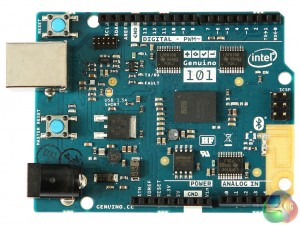- makeITcircular 2024 content launched – Part of Maker Faire Rome 2024Posted 2 weeks ago
- Application For Maker Faire Rome 2024: Deadline June 20thPosted 2 months ago
- Building a 3D Digital Clock with ArduinoPosted 7 months ago
- Creating a controller for Minecraft with realistic body movements using ArduinoPosted 7 months ago
- Snowflake with ArduinoPosted 8 months ago
- Holographic Christmas TreePosted 8 months ago
- Segstick: Build Your Own Self-Balancing Vehicle in Just 2 Days with ArduinoPosted 8 months ago
- ZSWatch: An Open-Source Smartwatch Project Based on the Zephyr Operating SystemPosted 9 months ago
- What is IoT and which devices to usePosted 9 months ago
- Maker Faire Rome Unveils Thrilling “Padel Smash Future” Pavilion for Sports EnthusiastsPosted 10 months ago
Intel Genuino 101 Review: can it replace the Pi?

The easiest way to describe the Genuino 101 is that “it’s a bit like the Raspberry Pi“. Except that it isn’t. Where the Pi is a tiny, cheap, programmable computer able to run a full operating system, the Arduino is more like a programmable co-processor, for creating low power devices that react to their environment.
Features:
- Intel Curie system-on-module
- 32MHz 32-bit Intel Quark x86 processor
- 32MHz 32-bit Argonaut RISC Core DSP sensor hub
- 128-node neural network
- 80Kb internal RAM, 384Kb internal Flash RAM
- 2MB USB-connected Flash storage
- Nordic nRF518 Bluetooth
- Bosch BMI160 six-axis accelerometer / gyroscope
- 14 digital Arduino headers, 4 with hardware power
- 6 analog inputs for ADC
- 3.3V I/O with 5V tolerance
- USB 1.1 interface, 5V DC, 500mA max
- 4 LEDs: green on D13, red for fault, green for activity, green for power
- DC input: 7-18V (20V max), 1A maximum current
- Compatible with standard Arduino IDE
Arduino isn’t the same kind of beast as the Raspberry Pi, and the Genuino 101 particularly so. The Arduino is for testing, prototyping and learning with the potential aim of developing ideas for the next generation of “ubiquitous computing” devices, such as wearable computing or the Internet of Things.
The Genuino 101 takes this another step forward. Most functions can be added to an Arduino with the judicious use of a Shield or some electronic components. But a couple of the most interesting and useful options come as standard with the Genuino 101. There’s a Bosch BMI160 six-axis accelerometer and gyroscope, plus a Nordic nRF518 Bluetooth chipset, feeding into the 32-bit DSP sensor hub that forms part of the Intel Curie system.
Intel has also recently made the firmware for the Genuino 101 available and open source, so the Arduino IDE won’t be the only way to access the rich array of features and functionality.
Final review score:
Pros:
- Fast 32MHz 32-bit Intel Quark x86 core.
- A lot more memory and local storage than regular Arduino boards.
- Six-axis accelerometer and gyroscope.
- Built-in Bluetooth BLE.
- Built-in real-time clock.
- Compatible with standard Arduino Shields.
- Compatible with standard Arduino components and projects.
Cons:
- Expensive compared to standard Arduino boards.
















One Comment